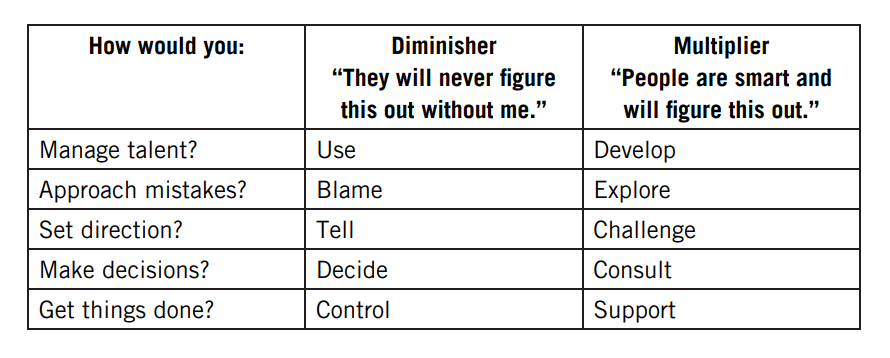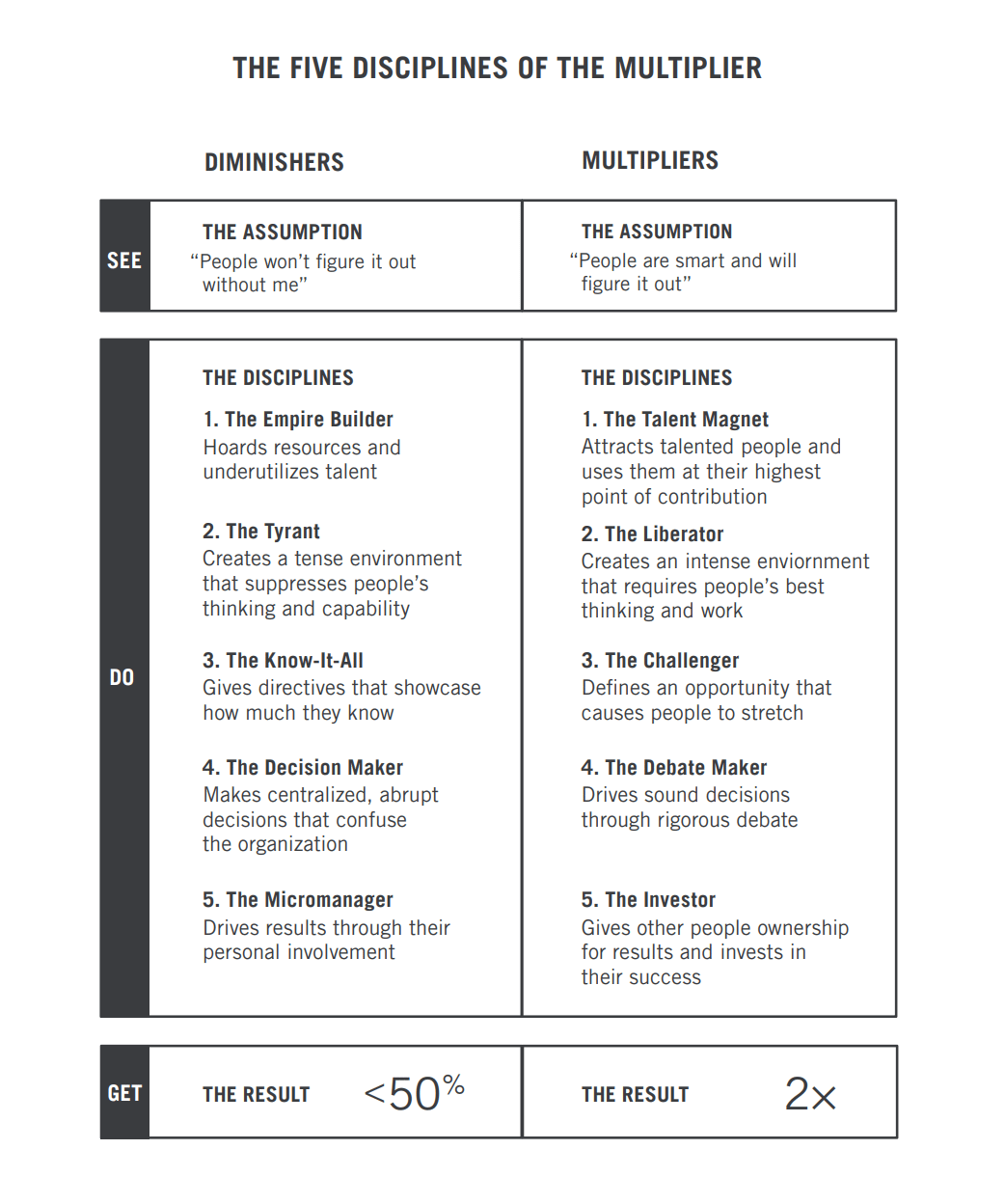- Leaders' Book Club
- Posts
- Are you a Multiplier or Diminisher?
Are you a Multiplier or Diminisher?
The power of multiplication in leadership
To conclude 2023 and kick off 2024, let’s consider the simple observation that there is more value inside our organizations or teams than we are using.
In fact, this is what inspired Liz Wiseman to write one of my all-time favorite leadership books: “Multipliers: How the Best Leaders Make Everyone Smarter”.
From a collegiate sports team and non-profit to an early-stage start-up, or a pre-IPO unicorn to a multi-national publicly traded company, the bottom line is we can’t afford leaders who fail to tap the collective intelligence and means of their people.
As Wiseman prefaces, nearly every organization in the world is resource constrained (unless, of course, you’re OpenAI, with ~$11.3 Billion in venture funding).
So, one bad leader, a Diminisher, can prove very costly: They may drain talent, waste millions of dollars, and stifle innovation - which may be the difference in capturing market share, achieving profitability, or winning a championship.
On the other hand, a Multiplier does the inverse: They get 100% (if not 2X) out of their people to drive innovation, short- and long-term positive outcomes, and cultures of high performance and fulfillment.
So, how can we move towards being a Multiplier and away from being a Diminisher?
Let’s start by defining and understanding them both in simple terms:
Multipliers are “genius makers who bring out the intelligence in others. They build collective, viral intelligence in organizations”.
Whereas Diminishers are “absorbed in their own intelligence, stifle others, and deplete the organization of crucial intelligence and capability”.
As such, each of their assumptions and actions differ quite a bit:

With these assumptions in mind, maybe you’re reminded of the Diminisher boss who just “decided” and never consulted your or the team’s opinion.
Or you recall a micro-manager who tried to control everything you did, or perhaps that one boss who tried to save face, blamed you for any mistakes, and never explored the “why” behind the outcome.
On the flip side, perhaps you’ve had a Multiplier manager that challenged you to set the direction of a project or supported you in different ways to get tricky problems solved instead of just solving them for you.
As such, we can extrapolate the different assumptions and examples of both Multipliers and Diminishers into what Liz Wiseman describes as the different disciplines (types) of Multipliers and Diminishers.
Take a second to read the chart below:

Now, ask yourself, which leaders/people come to mind that reflect these disciplines? Which do you see in yourself? Just one or a mix?
Personally, and as Liz Wiseman also acknowledges about herself, I find a mix of the Diminisher and Multiplier types in myself.
I’m undoubtably at fault for micromanaging in the past - especially in the early days of my management experience when I transitioned from an individual contributor to a people leader.
Heck, I know for a fact I’ve also made centralized decisions that would have been better informed or made by my team, and I am actively trying to do a better job of this today.
I too admit to creating an environment so intense that I’ve suppressed my team’s talent, where my intention was to do the opposite (this is where I fell into becoming what Wiseman coins as an “Accidental Diminisher”).
So, it’s fair to say I’ve spotted myself in the guise of the Diminisher in a few moments in my career so far.
I also know, on the flip side, that I wouldn’t be where I am today without being a Multiplier in other avenues and outweighing the Diminisher-like parts of my leadership journey.
I’ve been a “Talent Magnet”, having attracted, hired, developed, maximized, and promoted high performing and quality people.
I am also now more of “The Investor” vs. “The Micromanager” type of leader as I’ve grown in my career and adjusted my coaching to meet each person where they are at in their development.
I’ve also started to embody the “The Challenger” discipline that creates and defines opportunities for my team to stretch their capabilities, as well as “The Liberator” type where I now have calibrated an intensity that foments my team’s best work - not limits it.
As such, and in considering this duality of leadership, if we don’t reflect on how we’ve led in the past (the good, bad, and ugly) and evaluate how we lead now, we can’t optimize to be the multiplying leaders we aspire to be.
In other words, we must continue to learn from these reflections because at the end of the day, as John F. Kennedy famously said, “leadership and learning are indispensable to each other.”
So, the truth is that, as Wiseman suggests, you need to spot when you start showing Diminisher-like behavior and then course-correct, or when you exhibit Multiplier-like traits and then reinforce or expand them.
With this, it’s clear there is a continuum between a Multiplier and Diminisher, very rarely will we find others or ourselves on polar ends.
So, start with self-reflection and see where you land along the continuum.
Drill down and evaluate how much of each of the Diminisher and Multiplier types/disciplines you see in yourself.
Why? How did that become the case? What impact has this made on your team/organization? What can you do differently?
You may need to get feedback from your team or fellow leaders.
Most importantly, be honest about your spot along the Diminisher and Multiplier continuum and own it and act.
This is because the opportunity for you to inch closer to being a true Multiplier is omnipotent: the impact of being a Multiplier is tangible on your career and the organization or team you lead.
Again, being a multiplier could be the difference in jobs being saved, promotions made, the start-up surviving, a sports team winning a championship, or simply the bottom line to your fulfillment as a leader.
Strive to become a Multiplier yourself.
Find and create other Multipliers.
Then, as Liz Wiseman concludes, you’ll earn the ultimate respect and privilege of being a Multiplier of Multipliers.